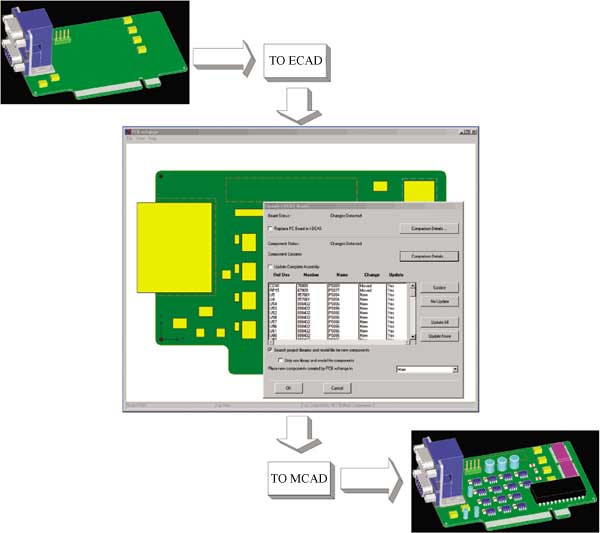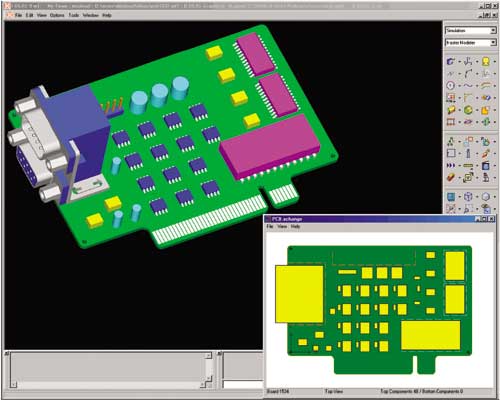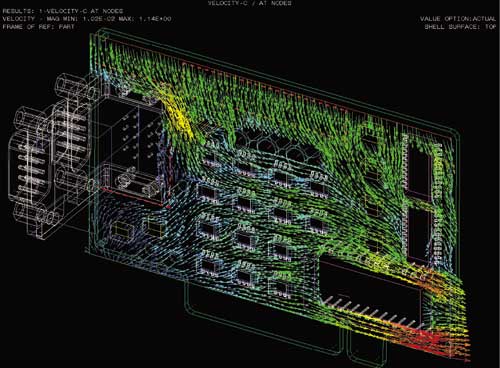Electronic data exchange represents a very important link for integrating PCB electrical layout, analysis and mechanical design. It has become, in fact, the basis for enhanced economic and industrial growth. The Intermediate Data Format (IDF) is the most used file format for exchanging printed circuit assembly (PCA) data between electrical and mechanical CAD/CAE systems and for allowing users of these systems to participate concurrently in the design of electro-mechanical products. Initially developed in 1992, the IDF has since become a de facto industry standard, implemented by most CAD vendors and widely used by their customers.
This article provides:
- An introduction to the IDF.
- An overview on the general processes of Integrated Product Design-Analysis (IPD).
- An example of design iterations between Mechanical Computer-Aided Design (MCAD) and Electrical Computer-Aided Design (ECAD) systems with tools to simplify the data exchange.
- A discussion of how thermal data are currently included during the IPD processes and what the latest IDF version (IDF 4.0) brings to provide real process integration.
The Intermediate Data Format
Excellent data exchange standards exist for communicating raw 3D geometric data such as IGES, DXF, STL and more rich data formats such as STEP. However, with the exception of STEP, none of these standards go much beyond geometric data and are unsuitable for the application specific data exchange required for PCA design. For example, thermal data and component attributes are not part of any of these data standards. STEP AP210 for PCA data exchange is an exception to this. The difficulties with AP210 is that it is a very complex and data rich specification and, secondly, it is currently supported by very few MCAD or ECAD vendors. In addition, AP210 does not define a means of including compact R-C thermal models of components.
The Intermediate Data Format (IDF) attempts to bridge the gap that exists between ECAD, MCAD and CAE software. Mentor Graphics and Structural Dynamics Research Corporation (Now EDS PLM Solutions) originally developed IDF in 1992 to exchange PCA design data between Mentor’s Boardstation and I-DEAS CAD/CAE products. The IDF has since become a de facto industry standard for PCA data exchange and is now supported by more than 25 MCAD and ECAD vendors. In addition, it is also supported by MAYA’s Electronic System Cooling thermal simulation software, Flomerics FLOTHERM software, and Mentor’s PCA level thermal tool, AutoTherm. Currently, Intermedius Design Integration maintains and develops the IDF standard. Their web site (www.intermedius.com) is an excellent source for the data standard specifications.
The first public version of the IDF, version 2, was released in January 1993. This is a relatively simple data exchange standard described in a 34 page document [1]. It defines board geometry, component placement and component footprints as well as PCB design attributes such as restriction areas and drilled holes. Basic 3D support is provided by defining component height and board thickness. The IDF3 specification [2] released in October 1996 expanded on IDF2 by adding manufacturing information and some optional component thermal data such as junction-to-case resistance and heat loads.
Significant new capabilities appear in the new version, IDF 4.0 Revision A [3], released in August 1998, as result of a project funded by leading MCAD/ECAD/MCAE vendors and end-users, and managed by Intermedius Design Integration. An important addition for thermal engineering is the ability to represent PCB thermal data and component thermal characterization data. A data representation for component compact thermal models has been proposed as part of this specification. This is an important achievement and represents the first data standard with semantic content for PCA and component thermal data exchange.
Integrated Product Design
Electronic and mechanical engineers and designers have been using CAD tools for more than a decade. Implementing CAD tools, and, in more recent years, 3D part and assembly design tools, have been key to shortening design-to-manufacturing schedules. Interestingly, most of the time and costs savings do not necessarily come from shortening a particular design task but rather by integrating design teams, applying concurrent engineering principles, and compressing the design-thru-manufacturing-thru-maintenance process as a whole. For example, an electronic product design team may spend considerably more time performing thermal analysis up front in the design process in order to save much more time later when designing, prototyping, and testing the final product design. The more rigorous thermal analysis may also reduce field failures. The additional time spent on analysis or 3D design and assembly are small compared to these savings.
Integrated Product Design (IPD) is key to shortening electronic product design schedules and getting to the market faster than the competition. One of the difficulties is linking together the different MCAD, ECAD and CAE (analysis) software packages used by engineers and designers – the infamous “islands of automation”. At the heart of most electronic products is copper-clad FR4 based printed circuit board assemblies. The PCA design touches all aspects of the product design process; examples include mechanical and electrical packaging, schematic capture, component placement, board routing, thermal engineering and EMI (See Figure 1).
 |
Figure 1. General PCB design integration process.
Design Update: MCAD-ECAD-MCAD
Using the IDF facilitates the design data transfer process between MCAD and ECAD. In most cases, the product packaging constrains the shape, size, and position of the PCAs used. Based on these package constraints, the mechanical designer determines the board outline and the size and locations of mounting holes for the board (if used). Note that the thickness of the board is usually a technology-driven standard – 0.062″ is the most common thickness.
Usually, the mechanical designer knows where to place certain critical components, such as connectors, LEDs, displays, and switches, because their locations are determined by the product packaging itself. Components preplaced by the designer can include mechanical components, such as card extractors, stiffeners, and other mechanical supports. Detailed 3D component models are used for preplacement in the mechanical CAD application. During the transfer, these reference the 2D footprints required by the ECAD application. Often, the mechanical designer indicates areas on the board where components cannot be placed, or where placement is limited by other obstructions in the overall assembly. The most common information transferred initially from MCAD to ECAD includes:
- Board outline (possibly, with cutouts)
- Board mounting holes
- Component mounting holes (if used to indicate component placement)
- Placement keepouts
- Placement of critical components
The layout designer uses the initial information from MCAD as the basis for creating the board part in ECAD. Often the layout designer adds additional placement and routing restriction areas, tooling holes, and fiducials. Occasionally, the designer modifies the board outline, but this is not common. However, the board outline is usually included in the update in case an MCAD translator needs it to build an entirely new assembly of the updated ECAD design. With the preplaced components from MCAD as a start, the layout designer places additional components. The locations of the preplaced components may need to be modified to accommodate routing considerations.
For those components that do not have detailed 3D models in MCAD, the MCAD IDF translators create extrusions of the ECAD component outlines by their height. Mounting holes defined in the components are transferred, resulting in holes in the board at appropriate locations. The information typically transferred back to MCAD from ECAD includes:
- Board outline (even if not modified)
- Tooling holes
- Fiducials
- Additional placement and routing areas
- Component shapes
- Component placement (modified and additional locations)
- Component mounting holes
Figure 2 shows a tool to compare a modified board assembly with the initial MCAD model. The new model contains additional placement areas, moved and new components. It shows also a selective update tool to add the layout designer’s changes into the initial MCAD model. The result is fewer errors, faster turnaround time and elimination of tedious work for mechanical engineers.
It may take several revisions between MCAD and ECAD to stabilize the design, or to accommodate product packaging or functional changes. The information exchanged during these revisions can be any or all of the information described above, depending on the magnitude of the change. Typically, it’s simply a modified board outline, a moved mounting hole, or some moved components. Typically, finalizing the board shape and component placement calls for 3-5 iterations. However, many companies require a dozen or more iterations per board design. A few companies do multiple iterations in a day.
 |
Figure 2. An example of transferring the PCB design and managing board and component revisions.
Component Mapping and Filtering
Another essential part of the PCB data exchange process is to coordinate component part information between ECAD and MCAD systems (Figure 3). The data exchange tool must provide simple methods to allow matching and filtering component data between MCAD and an ECAD system. Component mapping helps to maintain different component part names and numbers between MCAD and ECAD software. Filtering helps to remove small components and small board features such as pin holes for more efficient assembly modeling in MCAD. During the process of filtering, the data exchange tool should interactively preview IDF files and visualize the data exchange process in order to verify content before committing to revisions.
 |
Figure 3. An example of a PCB transfer from ECAD to MCAD using a filter on small components and restricted areas.
Thermal Data
The main limitation of IDF 2.0 and 3.0 is their non-support or partial support for thermal data. This affects the link between CAE (analysis) and MCAD and ECAD. In fact, thermal engineers do not use a standard, direct thermal data input; instead their thermal models are hand-made.
To facilitate thermal modeling, vendors must extend their tools and add support for meshing board and components and for exchanging thermal data. Mainly for the same reason, Mentor Graphics’ Autotherm introduced an interface based on the Intermediate Data Format IDF file set, called IDF 2.5. The IDF standard was modified to include board property and component property information for thermal modeling. Supporting IDF 4.0 could also be a good alternative for thermal data exchange to avoid the use a variety of non-standard tools.
Thermal Representation in IDF 4.0
In addition to the new capabilities, IDF 4.0 provides important addition for thermal/packaging engineers: The ability to represent PCB thermal data and component thermal characterization data (Figure 4).
 |
Figure 4. Example of a thermal/flow analysis on a PCB build using IDF-based data exchange.For the board, the thermal properties can be defined based on a stack of physical layers as well as conductors:
- Conductor pads and traces
- Thermal vias, thru and buried
- Conductive filled areas
- Physical layers, used to represent the physical characteristics and arrangement (stackup) of the physical layers that make up a board part
- Thermal material properties – used to define the material characteristics of board or physical layers; these can be isotropic and orthotropic
For components, the thermal data can be associated with individual component parts as well as component instances. This way, a component can have global properties, all or some of which can be overwritten by the component’s instance in the PCA. The following component properties to support thermal analysis are provided:
- Material properties for the component; isotropic or orthotropic with surface properties such as emissivity and roughness
- Specific physical and thermal properties, such as heat dissipation (min, max, nominal), thermal resistances (Rjc, Rjb, Rcb), thermal capacitance, and the thickness of the air-gap between the component and board
- Mounting type, surface or thru-hole, as well as pin quantity, size (length and area), locations and pin material
Summary
IDF 4.0 is based on IDF 2.0 and 3.0, which are supported by all major MCAD/ECAD vendors, but includes significant changes with respect to content, representation, and format. It is neither upward nor backward compatible with IDF 2.0 or 3.0. This is probably the reason why it has not been quickly adopted by MCAD and ECAD community. However, it provides an excellent opportunity for the thermal engineering community to implement a data standard for PCA product thermal representation and allows MCAD, ECAD and thermal analysis vendors to share PCA product models and provide real process integration.
References
- Intermedius Design Integration, “Intermediate Data Format – Mechanical Data Exchange Specification for the Design and Analysis of Printed Wiring Assemblies”, Version 2.0, Rev.3, San Jose, CA, Jan. 1993.
- Intermedius Design Integration, “Intermediate Data Format – Mechanical Data Exchange Specification for the Design and Analysis of Printed Wiring Assemblies”, Version 3.0, Rev.1, San Jose, CA, Oct. 1996.
- Intermedius Design Integration, “Intermediate Data Format – Data Exchange Specification for the Mechanical Design, Electrical Layout, and Physical Analysis of Printed Circuit Assemblies”, Version 4.0, Rev.A, San Jose, CA, July 1998.
- Kehmeier, D., “Electrical-Mechanical Design Integration: An Introduction to IDF 4.0 and What It Can Do for You”, Paper Presented at Mentor User Group Meeting, Intermedius Design Integration, San Jose, CA, Oct. 1998.
- Free, A., Kehmeier, D., Agonafer, D., “Driving PCA Thermal Analysis Using IDF 4.0 Data Exchange”, ASME InterPACK Conference, San Jose, CA, June 1999.










